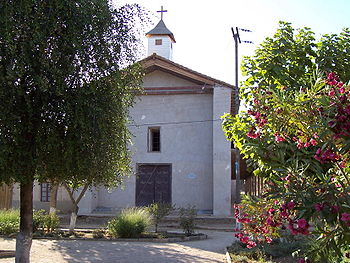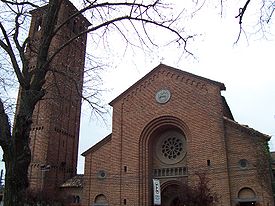- Roman Catholic Diocese of Linares
-
 Parish church of the village of Nirivilo, San Javier comuna, Linares Province, Chile. The building dates from Chile's colonial period. The parish belongs to the Diocese of Linares, Chile
Parish church of the village of Nirivilo, San Javier comuna, Linares Province, Chile. The building dates from Chile's colonial period. The parish belongs to the Diocese of Linares, Chile
The Roman Catholic Diocese of Linares, or "Diócesis de San Ambrosio de Linares", was established in Linares, Chile by Pope Pius XI on October 18, 1925 by means of the Bulla Notabiliter Aucto.
The Diocese of San Ambrosio de Linares, a suffragan Diocese of Santiago de Chile, is located in the geographical center of the country. The diocesan territory consists of two provinces: Linares Province and Cauquenes Province, and part of a third: Talca Province, all of them in the Maule Region of Chile. Compared to other Chilean Dioceses, Linares has a higher proportion of rural inhabitants. Numerous chapels have been raised, particularly in rural areas, over the last twenty years. The total number of chapels in the diocese is currently more than 450.
Contents
Brief History of the Diocese
In 1963, the territory of the Diocese of Linares expanded to include the parishes of the then Province of Maule (currently known as the Province of Cauquenes) that belonged to the Diocese of Chillán, and a parish (Putú), carved out from Talca Province. Prior to 1925, the territory now comprised by the Diocese was part of the ancient Diocese of La Santísima Concepción - now the Archdiocese of Concepción. The see of the Diocese and residence of the bishop is the city of Linares. The beautiful Cathedral Church is dedicated to Saint Ambrose of Milan.
Beginnings of Catholicism in the Region
Catholic evangelization in Chile began in the middle of the 16th century, shortly after the arrival of the Spaniards. Pedro de Valdivia granted Juan Jofré de Loaiza the encomienda of Peteroa, north of the Maule river on November 1, 1552 and shortly after, on 1554, Doctrina de Peteroa[1] was created under the care of priest Juan de Océs, son of Don Rodrigo de Océs, with orders to cross the "other towns" of remaining Indians to the north and south of the Maule river. As a result of the successful campaigns in southern Chile, the Diocese of Imperial was created on March 22, 1563. Following the Arauco War Bishop Don Reginaldo de Lizárraga went to the King Felipe III to obtain from the Pope the annexation of his Bishopric to the one of Santiago, to which the Supreme Pontiff acceded provisionally. This situation persisted from 1609 until 1623.
On February 18, 1585, the third Bishop of Santiago in his detailed report to King Felipe II mentions the missions of "Longomilla and Purapel", "Chanco and Loanco" taken care of by the presbítero Francisco de Maestanza, with a salary of three hundred and eighty pesos in gold and food".
The Doctrinas of Cauquenes and Putagán
When the Dioceses of Santiago and La Imperial were erected (in 1561 and 1564, respectively), the Maule river was considered the dividing line between the two Dioceses. However, it seems that the division was not sufficiently clear because the Bishop of Santiago, Fray Diego de Medellín (1576–1592), created two docrinas south of the Maule river that remained under the jurisdiction of the Santiago bishops for more than one hundred and seventy years. The doctrinas at issue were Cauquenes and Putagán. Cauquenes was erected in an area inhabited by the "cauquenes" Indians, who gave name to the region and the doctrina that was based there. In 1739 the Doctrinero Don José de Rozas and Amaza, who resided in Chanco, built a chapel in the seat of Cauquenes, the same place where Don José Antonio Manso de Velasco later founded the Villa de Nuestra Señora de las Mercedes de José de Manso de Tutuvén (Town of Our Lady of the Mercedes de José de Manso of Tutuvén, now Cauquenes) on May 9, 1742.
The Cathedral of San Ambrosio de Linares
The Cathedral Church of San Ambrosio, of Linares Diocese is considered to be one of the most important and finest religious buildings erected in Chile in the twentieth century. It replaced the original cathedral, after the latter was destroyed by an earthquake, in 1928. The new cathedral was conceived by bishop Juan Subercaseaux Errázuriz and its works were conducted by the renowned Chilean architects Carlos Bresciani and Jorge del Campo, the same duo that would be responsible, several years later, for the construction of another remarkable religious building, that of the parish church of Sagrado Corazón (Sacred Heart) in Providencia, Santiago de Chile.
Mgr. Subercaseaux gave a great initial impulse to the construction of the Linares Cathedral, which has been characterized as "the plastic expression of his refined artistic culture". Mgr. Subercaseaux, a dynamic and enterprising man, was not deterred by the shortage of resources available for the great work that had to be done. In his travels abroad, he was untiring to ask for greater resources for his diocese, which badly required some material aid that would help to finance the cathedral works as well as additional priests that would exercise their pastoral vocation in Linares diocese. In several countries (Italy, Germany, the United States, France, the Netherlands) Mgr Subercaseaux appealed to the local Catholics in their own languages, urging them to contribute to the progress of his far away diocese.
The cathedral was built according to the model of the famous Basilica of Sant'Ambrogio of Milan, a noble religious building built in Romanesque style and begun in the 4th century. The cathedral apse is remarkable for the outstanding mosaic work made by the Italian-born artist Giulio Di Girolamo. This mosaic work is one of the most important of its sort in South America.
On the 18 October 2006 the remains of Giulio Di Girolamo's wife, Elvira, brought from Italy, were buried in the Cathedral together with those of her husband, who had died in 1998 and had been buried in the Cathedral years before.
Diocesan Statistics
The Diocese of Linares has an area of 15,111 km² and its population is close to 350,000. More than 70% of its inhabitants consider themselves Catholic, (2002 Census).
Deaneries, parishes and priests of the Diocese
There are 33 parishes grouped into six Deaneries, including: Urban Linares, Parral, Cauquenes, Constitución, San Javier, Rural Linares.
Parishes of the Diocese
Urban Linares and Rural Linares Deaneries
- El Sagrario (Cathedral), Linares
- Nuestra Señora del Rosario, Linares
- Inmaculado Corazón de María, Linares
- María Auxiliadora, Linares
- Jesús Obrero, Linares
- Nuestra Señora del Carmen, Linares
- María Peregrina, Linares
- San Antonio de Padua, Linares
- Santos Chilenos, Linares
- Nuestra Señora de la Buena Esperanza, Panimávida
- San Miguel Arcángel, Colbún
- De la Santa Cruz, Yerbas Buenas
San Javier Deanery
- San Francisco Javier, San Javier
- Santísima Virgen de la Merced, San Javier
- Santa Rosa, Melozal
- Del Niño Jesús, Villa Alegre
- San Francisco, Huerta de Maule
- San Juan, Orilla de Maule
Parral Deanery
- San José de Parral, Parral
- San Francisco de Parral, Parral
- San Sebastián de Los Cuarteles, Parral
- San Lorenzo, Longaví
- San Ramón, Retiro
Constitución Deanery
- San José, Constitución
- Nuestra Señora del Tránsito, Putú
- Nuestra Señora del Carmen, Nirivilo
- San Ignacio, Empedrado
Cauquenes Deanery
- San Pedro, Cauquenes
- San Alfonso, Cauquenes
- Convento San Francisco, Cauquenes
- Santo Toribio, Curanipe
- San Luis Gonzaga, Sauzal
- San Ambrosio, Chanco
Priests of the Diocese
Francisco Lavín, Juvenal Pereira, René González, Erasmo Salazar, Plácido Grove, Hernán González, Rolf Schnitzler, Gabriel Lacaux, Jaime Vallet, Ramón Iturra, Luis Alarcón, Germán Cáceres, Silvio Jara, Lorenzo Solari, José Ulloa, Luis Retamal, Benjamín Retamales, Francisco Hormazábal, José Prado, Gonzálo Aravena, Luis Fuentealba, Raúl Moris, Alejandro Quiroz, Waldo Alfaro, Mario Agurto.
Bishops of the Diocese
- Miguel León Prado † (14 December 1925 - 3 March 1934 died in office)
- Juan Subercaseaux Errázuriz † (23 February 1935 - 8 January 1940 transferred as Archbishop to La Serena)
- Francisco Javier Valdivia Pinedo † (27 July 1940 - 1941 resigned before taking office)
- Roberto Moreira Martínez † (22 March 1941 - 2 February 1958 died in office)
- Augusto Osvaldo Salinas Fuenzalida † translated from the diocese of San Carlos de Ancud (15 June 1958 - 14 December 1976 retired)
- Carlos Marcio Camus Larenas translated from the diocese of Copiapó (11 December 1976 - 17 January 2003 retired)
- Tomislav Koljatic Maroevic (17 January 2003 - )
Monsignor Tomislav Koljatic Maerovic, who was auxiliary bishop of Concepción, from 1997 to 2003, is the current bishop of Linares.
Notes
- ^ The site where the evangelical proclamation took place was called a doctrina and the person in charge of a doctrina was a doctrinero. In general, the terms missionary and doctrinero had the same meaning
External links
Province of Antofagasta Province of Concepción Province of La Serena Province of Puerto Montt Province of Santiago de Chile Archdiocese of Santiago de Chile · Diocese of Linares · Diocese of Melipilla · Diocese of Rancagua · Diocese of San Bernardo · Diocese of San Felipe · Diocese of Talca · Diocese of ValparaísoSui iuris Jurisdictions Categories:- Roman Catholic dioceses in Chile
- Religious organizations established in 1925
- Roman Catholic dioceses and prelatures established in the 20th century
- Roman Catholic Ecclesiastical Province of Santiago de Chile
Wikimedia Foundation. 2010.

